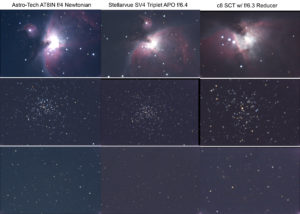Best EAA Scope? AT8NI vs c8 vs SV4 APO Comparison Review
By: Vlad Fedosov
Intro:
I would concider myself as a visual observer. I have tried to get into astrophotography on several occasions, but ever time I have concluded that its just not really for me. I was at a star party about a year(see Moro) ago and one of our club members had a basic electronically assisted astronomy(EAA) setup going with his 16” goto Dob. I was blown away by how quickly he was getting an image of the horsehead nebula in color! I thought that this EAA is something I need to look into.
Over the next year in my search for a perfect EAA scope I have done through many OTA’s. I’d like to look share my experiences with the most popular scope designs. The scopes that we will be comparing are: c8 with f/6.3 reducer, Astro-Tech AT8IN, and SV 102mm APO. I chose these scopes as they are some of the most common entry to mid-level scopes that are affordable to most common folks like us. If you are just getting into EAA, or perhaps looking for another scope to use for EAA I’m sure that this info will help you narrow down your search!

Testing:
I carried out this comparison of scopes in my mag 4 light polluted back yard on the same night, using the same mount and camera. I used the ASI 178MC camera for this comparison as it has a relatively small sensor that most people starting out in EAA will be using. All of the images where captures using SharpCap, saved “as viewed”, and with zero post-processing. I did a 3-minute stack of 5-second subs at 400 grain for all of the images. I chose 3 targets that range from very easy to difficult including: m42(nebula), m37(open cluster), NGC 1275(Perseus galaxy cluster). For the most part, I think the images speak for themselves:

Conclusion:
Overall if you can swing the cost of a triplet APO I think that is the way to go for a majority of deep sky EAA images with a smaller sensor camera. You get a field of view(FOV) that is wide enough to capture the majority of objects and nice crisp stars all across the FOV. You also do not have to worry about collimation! If you cannot spend the money on a triplet the decision gets a bit harder as secondary color is a bother with less expensive achromatic and ED doublet lenses(see: Revolution 80mm). An 8” SCT is probably my second choice, especially if you are interested in doing some planetary imaging. It is fairly easy to reduce down an SCT to f/3.3 with a Meade reducer and you can go up in focal length as high as your seeing will allow for planetary work. If you are into small galaxies or planetary nebula then the SCT might be a better choice as well. The Newtonian is perhaps the least expensive scope to get into EAA and is certainly capable of some decent images but it does display some coma even with a small sensor like the 178MC
Support AVT-ASTRO
If you found this review helpful and are considering purchasing the product that was discusses please consider purchasing this item on Agena Astro using the link here. I get a small commission from Agena Astro and it really helps to pay for running this site!
